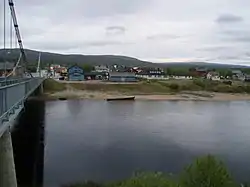Karasjok (village)
![]() Karasjok (Northern Sami: Kárášjohka [ˈkʰaːraːʃˌjohka];[3] Kven: Kaarasjoki) is a municipality in Troms og Finnmark county, Norway.
Karasjok (Northern Sami: Kárášjohka [ˈkʰaːraːʃˌjohka];[3] Kven: Kaarasjoki) is a municipality in Troms og Finnmark county, Norway.
Karasjok kommune
Kárašjoga gielda Kaarasjoki | |
|---|---|
Municipality | |
 | |
 Flag  Coat of arms  Troms og Finnmark within Norway | |
 Karasjok within Troms og Finnmark | |
| Coordinates: 69°28′55″N 25°06′18″E | |
| Country | Norway |
| County | Troms og Finnmark |
| Established | 1 Jan 1866 |
| Administrative centre | Karasjok |
| Government | |
| • Mayor (2015) | Svein Atle Somby (Ap) |
| Area | |
| • Total | 5,452.95 km2 (2,105.40 sq mi) |
| • Land | 5,209.46 km2 (2,011.38 sq mi) |
| • Water | 243.49 km2 (94.01 sq mi) 4.5% |
| Area rank | 2 in Norway |
| Population (2020) | |
| • Total | 2,628 |
| • Rank | 245 in Norway |
| • Density | 0.5/km2 (1/sq mi) |
| • Change (10 years) | −5.8% |
| Demonym(s) | Karasjoking[1] |
| Time zone | UTC+01:00 (CET) |
| • Summer (DST) | UTC+02:00 (CEST) |
| ISO 3166 code | NO-5437 |
| Official language form | Bokmål and Northern Sami[2] |
| Website | karasjok |
The municipality (of which the urban area is a part,) has Sami and Norwegian as official languages.
The municipality is one of two in Norway where the majority of inhabitants speak Sami and have it as their main language.[4]
History
Before the beginning of the 1700s, there might not have been a permanent population there.[5] However the area was used by nomads.[5]
World War II
During World War II a Nazi concentration camp was built in Karasjok: Lager IV Karasjok (German for "Karasjok Camp No.4", Norwegian: Karasjok fangeleir).[6][7] The camp was run by SS, and it was among[8] the first four Nazi concentration camps in Northern Norway.
In July 1943, 374 political prisoners and POWs prisoners [mostly Yugoslav,] were brought to the concentration camp. They were tasked with widening the road to Karigasniemi, Finland.[9] After four or five months, only 111 of these prisoners were still alive.[9] At the end of the prisoners' stay in Karasjok, before transportation out of Karasjok, 45 prisoners were massacred by the firing of small arms.[9] At least one former prisoner is (as of 2013) still alive.[10]
Education
Main language of students at secondary school
The Sami secondary school, is one of two in Norway (as of 2014);[12] 73% of the schools students say that Sami is their main language; 27% say that Sami is their second language (as of the school year that started in [August] 2009 and ended in [June] 2010);[13] That school is run by the government.
References
- "Navn på steder og personer: Innbyggjarnamn" (in Norwegian). Språkrådet.
- "Forskrift om målvedtak i kommunar og fylkeskommunar" (in Norwegian). Lovdata.no.
- "Stadnamn og rettskriving" (in Norwegian). Kartverket. Archived from the original on 2018-07-01. Retrieved 2018-07-13.
- ÁVJOVÁRRI URFOLKSREGION I ET SAMISK PERSPEKTIV. page 19
- Dalfest, Terje; Askheim, Svein (19 January 2019). "Karasjok" – via Store norske leksikon.
- Sigurd Bakke Styrvold, "Heil og Sæl. Jeg er utdannet morder!" - Den norske SS Vaktbataljon 1942 – 45" (PDF), MA in history - University of Oslo (in Norwegian), p. 14
- Timm C. Richter. Krieg und Verbrechen: Situation und Intention: Fallbeispiele. 2006. p. 114
- Sigurd Bakke Styrvold, "Heil og Sæl. Jeg er utdannet morder!" - Den norske SS Vaktbataljon 1942 – 45" (PDF), MA in history - University of Oslo (in Norwegian), p. 14,
Det fantes på forskjellige tidspunkter flere serberleire i Norge, men de norske vaktene gjorde bare tjeneste i de fire første; Lager I Beisfjord, Lager II Elsfjord, Lager III Rognan (også kjent som Botn) og Lager IV Karasjok
- Disse fangene bygget «blodveien» – og så ble de henrettet - De jugoslaviske fangene som var i Karasjok under andre verdenskrig skulle bare bygge veien til Finland, og deretter skulle de ikke eksistere mer. [These prisoners built 'the blood road' - and then they were executed - The Yugoslavian prisoners that were in Karasjok during World War Two, were only to build a road to Finland, and thereafter they were not to exist anymore]
- Larsen, Dan Robert (24 May 2013). "Følelsesladet møte med Karasjok". NRK.
- Larsen, Dan Robert (2 June 2016). "Flytter Sápmi Pride til Kautokeino". NRK.
- Fornyings-, administrasjons-og kirkedepartementet (20 August 2018). "Fakta om samiske språk". Regjeringen.no.
- "Urbefolkningen i tall - samisk statistikk". ssb.no.